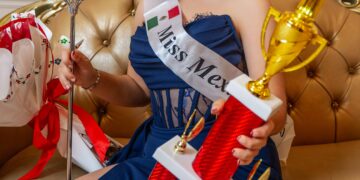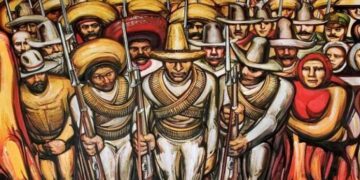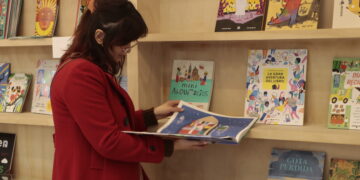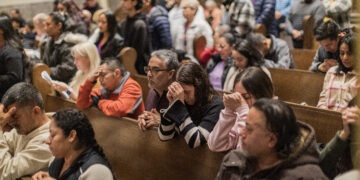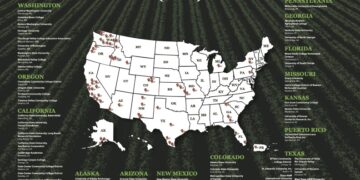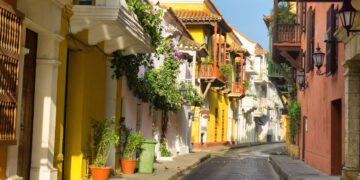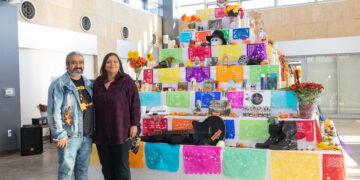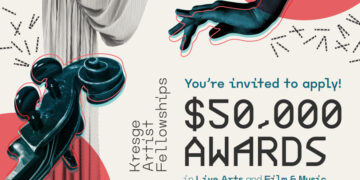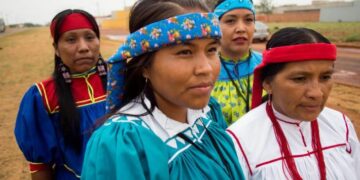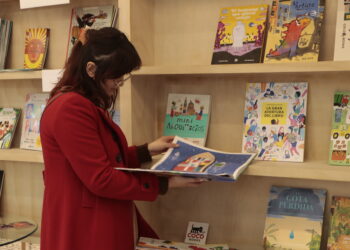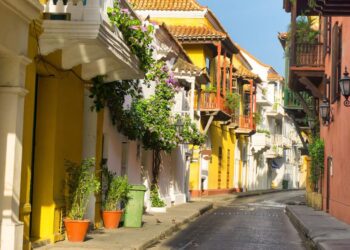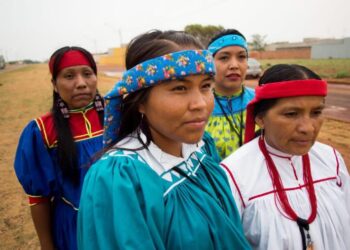Nicaragua es un país ubicado en el Istmo de Centroamérica, siendo también el más grande de toda la región centroamericana contando con menos de siete millones de habitantes. El pueblo nicaragüense es de naturaleza multiétnica y el español es la lengua oficial, aunque también son reconocidas las lenguas de los pueblos indígenas originarios como el inglés criollo nicaragüense, misquito, Sumu o Sumo, Garífuna y Rama. Cuenta con costa en el Océano Atlántico y en el Oceáno Pacífico. Al noroeste colinda con Honduras y al sureste con Costa Rica. Su capital es Managua. En su territorio se pueden encontrar grandes volcanes con bastante popularidad, como es el volcán San Cristóbal, el más alto del país, también está el volcán Cerro Negro, conocido por su actividad turística de sandboarding, el volcán Masaya, con su cráter activo, y el volcán Momotombo, que se encuentra cerca de Managua; así como, dos grandes lagos en la zona rumbo al pacífico, el Lago Cocibolca, el más grande del país, el Lago Xolotlán y la Laguna de Perlas que colinda con el Océano Atlántico.
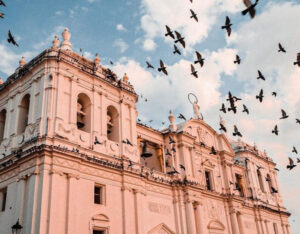
León
La ciudad de León, Santiago de los Caballeros de León, rodeada de volcanes se encuentra a 20 kilómetros del Océano Pacífico. A pesar de contar con cerca 230,000 habitantes es considerada la sede intelectual de Nicaragua, esto se debe a que en 1812 se fundó la Universidad de León, actual Universidad Nacional Autónoma de Nicaragua.
Fue en León donde murió el gran poeta Rubén Darío, “príncipe de las letras castellanas”, y quien trajo el modernismo a la literatura latinoamericana con su gran poemario Azul.
Es la segunda ciudad más importante del país con una colorida arquitectura de techos de teja y estilo colonial parece congelarse en el tiempo.
Entre 1747 y 1814 se llevó a cabo la construcción La Insigne y Real Basílica Catedral de la Asunción de la Bienaventurada Virgen María, más conocida como Catedral de León, siendo ésta la más grande de toda la región centroamericana, considerada como Patrimonio de la Humanidad debido a su esplendorosa arquitectura barroca y neoclásica. La azotea de la misma es un gran punto turístico debido a sus suelos blancos y redondos debido a las cúpulas de la gran iglesia.
Receta: Gallo Pinto
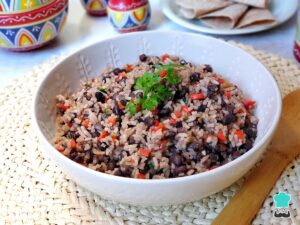
Ingredientes Gallo Pinto:
- 1 libra Arroz blanco
- 1 libra Frijoles Rojos cocidos
- 5 cucharadas de Aceite
- 1 Chiltoma o Pimiento Verde
- 1 cebolla mediana
Preparación
- Comienza con hacer 1 libra de arroz blanco, corta media cebolla en trocitos y agrégalo a un sartén u olla con dos cucharadas de aceite. Cuando la cebolla tenga una consistencia doradita agrega el arroz, junto con las 4 tazas de agua y déjalo freír hasta que quede bien suelto.
- Luego deja que se enfríe un poco para que no quede masudo.
- Posteriormente pon a sofreír los frijoles corta la otra media cebolla en trocitos y agrégalo a un sartén u olla con dos cucharadas de Aceite Ideal Soya cuando tenga consistencia doradita, agregas el frijol de tal forma que se mantengan su consistencia entera. Evita moverlos demasiado para que no se deshagan.
- Utiliza otro sartén con una cucharada de aceite. Úsalo solo para sofreír el arroz y frijoles haciendo la mezcla del Gallo Pinto hasta que tomen un color morado.
- Condiméntalo con Chiltoma verde sofrito bien picadito.
- También puedes agregar trozos de pollo o cerdo dándole ese toque especial a sus recetas de gallo pinto nicaragüense.
Rubén Darío – Azul
Primaveral
Mes de rosas. Van mis rimas
en ronda a la vasta selva
a recoger miel y aromas
en las flores entreabiertas.
Amada, ven. El gran bosque
es nuestro templo; allí ondea
y flota un santo perfume
de amor. El pájaro vuela
de un árbol a otro y saluda
tu frente rosada y bella
como un alba; y las encinas
robustas, altas, soberbias,
cuando tú pasas agitan
sus hojas verdes y trémulas,
y enarcan sus ramas como
para que pase una reina.
¡Oh, amada mía! Es el dulce
tiempo de la primavera.
Mira en tus ojos, los míos,
da al viento la cabellera,
y que bañe el sol ese oro
de luz salvaje y espléndida.
Dame que aprieten mis manos
las tuyas de rosa y seda,
y ríe, y muestren tus labios
su púrpura húmeda y fresca.
Yo voy a decirte rimas,
tú vas a escuchar risueña;
si acaso algún ruiseñor
viniese a posarse cerca,
y a contar alguna historia
de ninfas, rosas o estrellas,
tú no oirás notas ni trinos,
sino, enamorada y regia,
escucharás mis canciones
fija en mis labios que tiemblan.
¡Oh, amada mía! Es el dulce
tiempo de la primavera.
Nicaragua is a country located on the Isthmus of Central America, and is also the largest in the entire Central American region, with less than seven million inhabitants. The Nicaraguan people are multiethnic, and Spanish is the official language, although indigenous languages such as Nicaraguan Creole English, Miskito, Sumu (or Sumo), Garifuna, and Rama are also recognized. It has coastlines on the Atlantic Ocean and the Pacific Ocean. It borders Honduras to the northwest and Costa Rica to the southeast. Its capital is Managua. Large and popular volcanoes can be found within its territory, such as San Cristóbal, the highest in the country. Cerro Negro, known for its sandboarding tourism, Masaya, with its active crater, and Momotombo, located near Managua. as well as two large lakes in the area heading towards the Pacific, Lake Cocibolca, the largest in the country, Lake Xolotlán and the Pearl Lagoon that borders the Atlantic Ocean.

León
The city of León, Santiago de los Caballeros de León, surrounded by volcanoes, is located 20 kilometers from the Pacific Ocean. Despite having a population of nearly 230,000, it is considered the intellectual center of Nicaragua. This is due to the founding of the University of León, now the National Autonomous University of Nicaragua, in 1812.
It was in León that the great poet Rubén Darío, “prince of Castilian letters,” died. He brought modernism to Latin American literature with his great collection of poems, Azul.
It is the second largest city in the country, with colorful architecture of tiled roofs and a colonial style that seems frozen in time.
Between 1747 and 1814, the construction of the Insigne and Royal Cathedral Basilica of the Assumption of the Blessed Virgin Mary, better known as León Cathedral, was completed. It is the largest in the entire Central American region and is considered a World Heritage Site due to its splendid Baroque and Neoclassical architecture. The roof of the same is a great tourist spot due to its white floors and rounded due to the domes of the great church.
Recipe: Gallo Pinto

Ingredients:
- 1 pound white rice
- 1 pound cooked kidney beans
- 5 tablespoons oil
- 1 bell pepper or green pepper
- 1 medium onion
Preparation
- Start by making 1 pound of white rice, chop half an onion into small pieces, and add it to a pan or pot with two tablespoons of oil. When the onion has a golden consistency, add the rice, along with the 4 cups of water, and let it fry until it’s very loose.
- Then, let it cool slightly so it doesn’t become soggy.
- Then, sauté the beans, chop the other half of the onion into small pieces, and add it to a pan or pot with two tablespoons of Ideal Soya Oil. When it has a golden consistency, add the beans until they remain uniform. Avoid stirring them too much to prevent them from falling apart.
- Use another pan with a tablespoon of oil. Use it alone to sauté rice and beans in the Gallo Pinto mixture until they turn purple.
- Season it with finely chopped sautéed green chilies.
- You can also add chunks of chicken or pork to give your Nicaraguan gallo pinto recipes that special touch.
Ruben Dario – Blue
Springtime
Month of roses. My rhymes
circle the vast forest,
stoop to pluck the scent of honey
from half-opened flowers.
Come to me, my love. The woods
are our great temple. There’s a wave,
a whiff of the sacred perfume
of love. A bird flutters between the trees,
greets the beauty of your pink forehead
just as it would the dawn. And the oaks,
so tall, so square-shouldered and proud,
quiver as you pass,
their green leaves shuddering,
locking their branches in an arc
as if a queen were walking through.
My love, these are sweet
days: it is spring.
Gaze into my eyes through yours.
Offer the tangle of your hair
to the wind, let this ring of savage
light bask in the spender of the sun.
Give me your hands, those silky
roses, so I can hold them in mine.
Then laugh: bare your lips
of fresh, moist purple.
I will read you my poems
and you will smile as you listen.
If, by chance, a nightingale
settles close by and starts
to tell tales of nymphs,
of roses, of stars,
you will be deaf to its music,
its warbles. All regal and besotted,
you will listen to my songs instead,
watching the twitch of my lips.
My love, these are sweet
days: it is spring.


